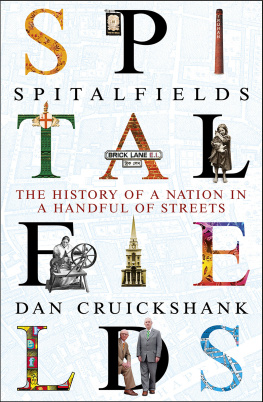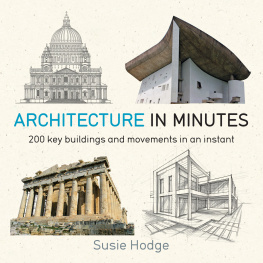Dan Cruickshank - A History of Architecture in 100 Buildings
Here you can read online Dan Cruickshank - A History of Architecture in 100 Buildings full text of the book (entire story) in english for free. Download pdf and epub, get meaning, cover and reviews about this ebook. year: 2015, publisher: HarperCollins UK, genre: Religion. Description of the work, (preface) as well as reviews are available. Best literature library LitArk.com created for fans of good reading and offers a wide selection of genres:
Romance novel
Science fiction
Adventure
Detective
Science
History
Home and family
Prose
Art
Politics
Computer
Non-fiction
Religion
Business
Children
Humor
Choose a favorite category and find really read worthwhile books. Enjoy immersion in the world of imagination, feel the emotions of the characters or learn something new for yourself, make an fascinating discovery.
- Book:A History of Architecture in 100 Buildings
- Author:
- Publisher:HarperCollins UK
- Genre:
- Year:2015
- Rating:5 / 5
- Favourites:Add to favourites
- Your mark:
- 100
- 1
- 2
- 3
- 4
- 5
A History of Architecture in 100 Buildings: summary, description and annotation
We offer to read an annotation, description, summary or preface (depends on what the author of the book "A History of Architecture in 100 Buildings" wrote himself). If you haven't found the necessary information about the book — write in the comments, we will try to find it.
A History of Architecture in 100 Buildings — read online for free the complete book (whole text) full work
Below is the text of the book, divided by pages. System saving the place of the last page read, allows you to conveniently read the book "A History of Architecture in 100 Buildings" online for free, without having to search again every time where you left off. Put a bookmark, and you can go to the page where you finished reading at any time.
Font size:
Interval:
Bookmark:


William Collins
An imprint of HarperCollinsPublishers
1 London Bridge Street
London SE1 9GF
WilliamCollinsBooks.com
This eBook first published in Great Britain by William Collins in 2015
Copyright Dan Cruickshank 2015
Dan Cruickshank asserts the moral right to be identified as the author of this work
A catalogue record for this book is available from the British Library
Edited and designed by Tall Tree Ltd
Cover photograph Interim Archives / Getty Images
All rights reserved under International and Pan-American Copyright Conventions. By payment of the required fees, you have been granted the non-exclusive, non-transferable right to access and read the text of this e-book on-screen. No part of this text may be reproduced, transmitted, down-loaded, decompiled, reverse engineered, or stored in or introduced into any information storage and retrieval system, in any form or by any means, whether electronic or mechanical, now known or hereinafter invented, without the express written permission of HarperCollins
Source ISBN: 9780007575589
Ebook Edition October 2015 ISBN: 9780007575596
Version: 2015-08-26

CHAPTER 1:
PIONEERS
CHAPTER 2:
RHETORIC (BUILDING WITH A MESSAGE)
CHAPTER 3:
SACRED
CHAPTER 4:
URBAN VISIONS
CHAPTER 5:
BIG AND BEAUTIFUL
CHAPTER 6:
MATERIAL MATTERS
CHAPTER 7:
LOST AND FOUND

Dan Cruickshank
The Taj Mahal at Agra, India, is one of the most famous buildings in the world and still one of the most satisfying to visit. Built between 1632 and 1653 as a tomb and shrine to the dead, the building is through the beauty of its design, construction, and setting a monument to the wonder of life and to the transcendental power of architecture.
This book offers a history of world architecture through the stories of 100 buildings. The selection includes many of the worlds best-known buildings that represent key or pioneering moments in architectural history, but there are also less obvious and more humble structures, the generally unsung heroes of a great and fascinating story. Virtually all the buildings included are ones that Ive seen this has been one of the criteria of selection so the story this book tells is a most personal and intimate affair. In addition, buildings have been selected to represent most major building types and a wide geographic spread that reflects the architectural aspirations of many cultures through many epochs.
By its nature a history of architecture is also a history of many other things of politics, economy, society, religion, science, and ecology, and of art and culture generally and so is essentially a history of the world. For architecture, in its forms and functions, is a very direct mirror of mankinds desires, concerns, and ambitions.
Architecture has created bastions of defence and aggression, homes for the gods and the dead; temples of commerce and of the arts; palaces to express taste, power, and wealth; and shrines of science, of learning, knowledge, and politics but also of Mammon and of physical and spiritual subjugation and incarceration. Can an ignoble cause create great architecture? Can a great fortress perhaps a place of oppression be a thing of beauty as well as of power? These are perennial philosophical questions that this book seeks to answer.
The book also explores moments of human madness when culture comes under fire. During war, and because of ideological, political, or religious conflict, buildings particularly cities have been targets, sometimes victims of collateral damage and sometimes of direct and brutal attack. This book documents this dark side of the story of architecture, referring to examples from history and from the present, including in Iraq, where in March 2015 architecture and art of great age and beauty were deliberately destroyed a stark and tragic sacrifice to mankinds ability to lose itself in intolerance and unbridled fury. These recent losses notably the attacks on the cultural treasures of the ancient city sites of Nineveh, Nimrud, and Hatra, long regarded as among the worlds most precious antiquities make clear that in our increasingly hostile, volatile, and divided, world nothing is safe.
Together, the stories told in this book offer a global cultural history a history that is still in part mysterious and ripe for informed speculation. Some of the basic facts to do with the emergence, construction, and evolution of these edifices remain unknown or contested and obscured by ancient myth and legend. How was the Great Pyramid at Giza designed and constructed with such breathtaking perfection and accuracy around 4,550 years ago? In what circumstances did the classical architecture of the Greek world reach maturity nearly 2,600 years ago? By what leap of imagination and engineering skill did the revolutionary system of Gothic architecture suddenly emerge in fully formed manner in the early twelfth century?

Dan Cruickshank
One of the towering, pyramidal gopura at Sri Ranganathaswamy Temple in south India. Images of guardian spirits protect the route, through the gopura , leading to the Vishnu shrine that lies at the heart of this great Hindu temple town.
The rise of the Gothic is a fantastic story. What is its relationship with contemporary Islamic architecture of the Middle East and Southern Spain, and was the grain of the Gothic idea gathered during the Crusades and brought back to Western Europe?
In a generation in Europe in the very early twelfth century, all structural traditions were dramatically revised and an integrated system of skeletal architecture comprising ribs, piers, and buttresses replaced the tried and trusted tradition of wall architecture, in which loads were transferred and restrained through the means of walls of great strength. Suddenly architects, masons, and engineers grasped the potential of strength not through mass but by design. Materials could be given added strength if used in a well-calculated manner and structures of great strength could be minimal if all was conceived in harmony, with the thrust of forces being met and balanced by opposite and equal counter-thrusts for example, the lateral thrust of the weight of a stone vault being met with the counter-thrust of a well-placed flying buttress. This was an architecture that largely relieved the wall of its structural and load-bearing role, freeing it to be pierced by huge windows that, filled with stained glass, allowed Gods light and message to flood into the interiors of churches and cathedrals.
Even the very definition of architecture, as opposed to mere building, has been debated and honed for generations. The Roman architect and theorist Vitruvius, in the first century BC , offered the oldest known definition: that architecture must embody commodity, firmness, and delight. In simple terms this means that architecture must be functional and fit for purpose (in other words, commodious), and that it must be structurally sensible and sound, and so possess firmness. But for mere building to become architecture it must also attain the poetry of beauty; it must possess a meaning and a spiritual quality that feeds and inflames the imagination, that satisfies human fancies that delights.
Font size:
Interval:
Bookmark:
Similar books «A History of Architecture in 100 Buildings»
Look at similar books to A History of Architecture in 100 Buildings. We have selected literature similar in name and meaning in the hope of providing readers with more options to find new, interesting, not yet read works.
Discussion, reviews of the book A History of Architecture in 100 Buildings and just readers' own opinions. Leave your comments, write what you think about the work, its meaning or the main characters. Specify what exactly you liked and what you didn't like, and why you think so.














